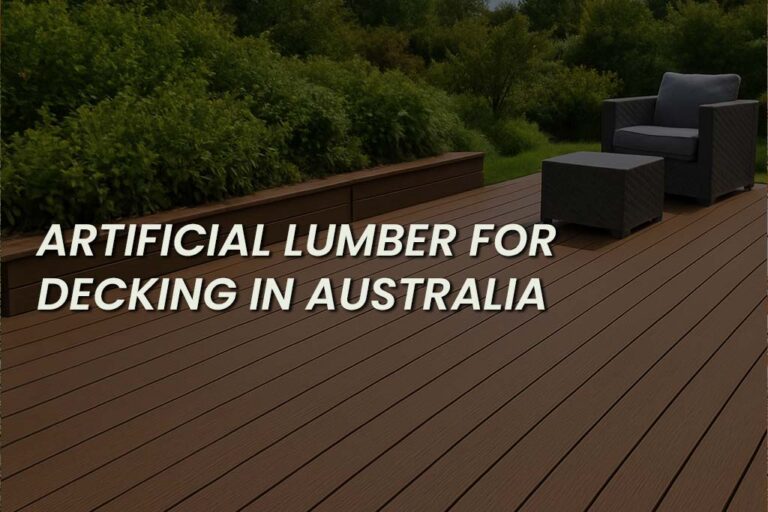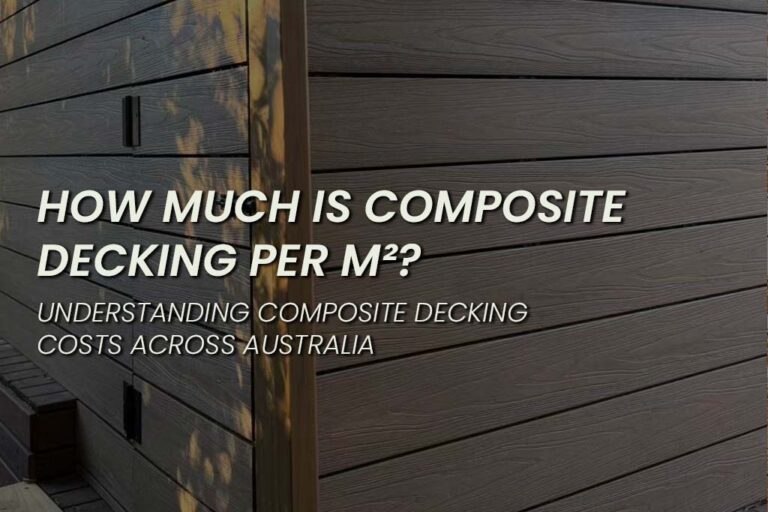Does mould Grow on Composite Decking?
Composite decking is highly resistant to insect damage and much more effective than timber yet if not cleaned regularly can still collect dirt and moisture that allows mould to form. This guide explains the science behind mould growth on decks, outlines local climate factors, and offers practical steps for prevention, cleaning and long term care.
Understanding Composite Decking
Composite decking combines recycled wood fibres with plastic polymers to create boards that look like timber but require much less maintenance. The wood fibres give a natural texture while the plastic repels water. A protective cap on many boards adds resistance to stains, scratches and colour fade. Proper installation with correct joist spacing and airflow beneath the deck helps the surface dry quickly yet debris can still settle in grooves if not cleaned.
Compared with traditional timber, composite decking requires no annual sanding, staining,sealing or fastener ‘’tightening’’. A simple sweep and rinse keeps the surface clear of dirt and leaves. Consistent board dimensions remove splinter hazards and make installation easier. Although composite decking prices are higher up front than timber, lower upkeep and longer lifespan balance the investment. Not forgetting at least 15% of timber purchased will most likely go to the tip due to splits, knots and variations in boards supplied.
Composition and key materials used in composite decking boards
Each board begins with a core made of wood flour or fibres mixed with plastic resin. This blend typically comprises fifty to sixty per cent wood content joined with thirty to forty per cent polymers. Additives such as UV stabilisers protect against sun damage while some caps include antimicrobial agents to slow algae and mould formation. Also fire retardant to allow quality composites to offer a BAL 29 rating.
Many profiles feature composite decking boards with grooved edges for hidden fix installation and smooth faces that shed dirt more easily. Understanding shell and core design helps you choose between texture and ease of cleaning.
Benefits compared with traditional timber decking
Natural timber absorbs water, which over time can cause warping, bowing, cracking, and rot. In contrast, composite boards are highly resistant to moisture, holding their shape and reducing the risk of structural damage. They also maintain consistent colour year after year, thanks to integrated pigments and protective caps that help combat excess UV rays.
Where Australian homeowners once spent precious leisure hours — sometimes entire weekends — resealing their timber decks, they can now enjoy the ease of a simple monthly rinse to keep surfaces looking fresh. This practical advantage means more time spent enjoying the deck, and less time maintaining it.
How mould Develops on Decking
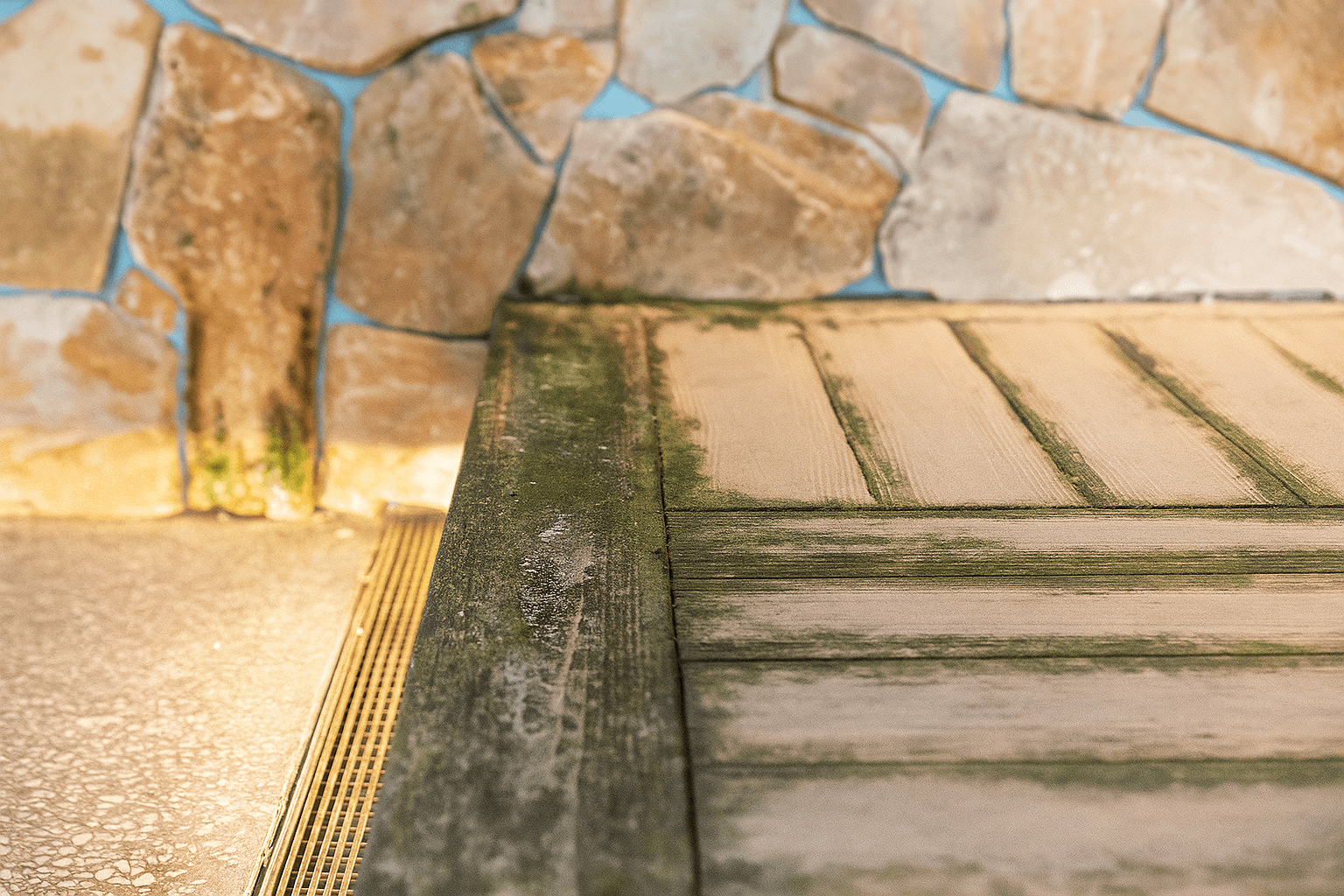
Mould spores travel through air and settle on any damp surface with organic matter. On a deck, leaves, pollen and bird droppings become food sources. If moisture remains after rain or morning dew spores germinate into visible growth. Composite decks shed water more readily than timber yet surface moisture and debris in grooves can still allow mould to take hold.
Outdoor mould thrives in shady humid spots where sunlight and wind cannot dry the surface. Pollen blowing in spring and fallen leaves in autumn feed spores if not removed. Coastal and subtropical climates with high rainfall keep decks damp for long periods. Understanding how mould forms lets you target problem areas early with simple cleaning.
Conditions that support mould growth on outdoor surfaces
Persistent moisture is the primary driver. Decks shaded by trees, pergolas or awnings can stay wet hours after a shower. High humidity above sixty per cent slows evaporation overnight giving spores time to grow. Cool temperatures under twenty degrees also extend drying times and favour fungal activity.
Organic debris supplies nourishment. Fine dust pollen and leaf fragments collect in board channels and around fixings. If left unchecked these particles act like a sponge holding water and feeding spores. Direct sun and moving air help dry surfaces so decks in open sunny areas show less mould over time.
Poor sub deck ventilation traps moisture beneath boards. Ensuring there are gaps under the deck promote air movement reducing humidity and prevents mould from spreading under the deck.
Differences between composite and timber in moisture absorption
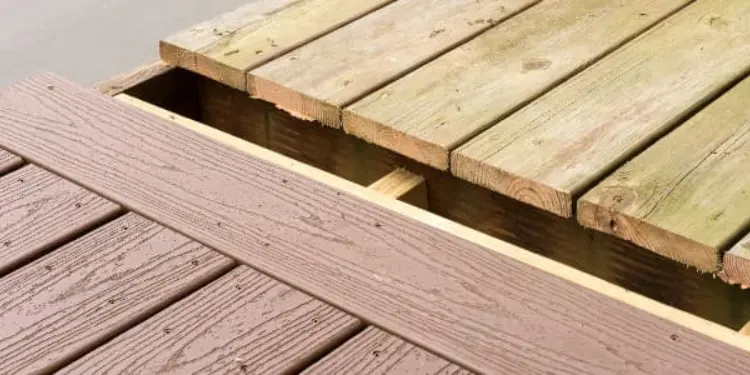
Timber is porous and soaks up water through end grains and surface cracks causing swelling and warping. That wood then provides a food source for fungal growth inside the fibres. Composite boards feature a dense core and protective cap that dramatically limits water uptake. The plastic content repels moisture and the cap seals entry points.
Although not fully waterproof, composite boards dry faster and resist the decay processes that plague timber. Knowing these material differences shows why composite decks need less sealing.
Environmental Factors in Australia
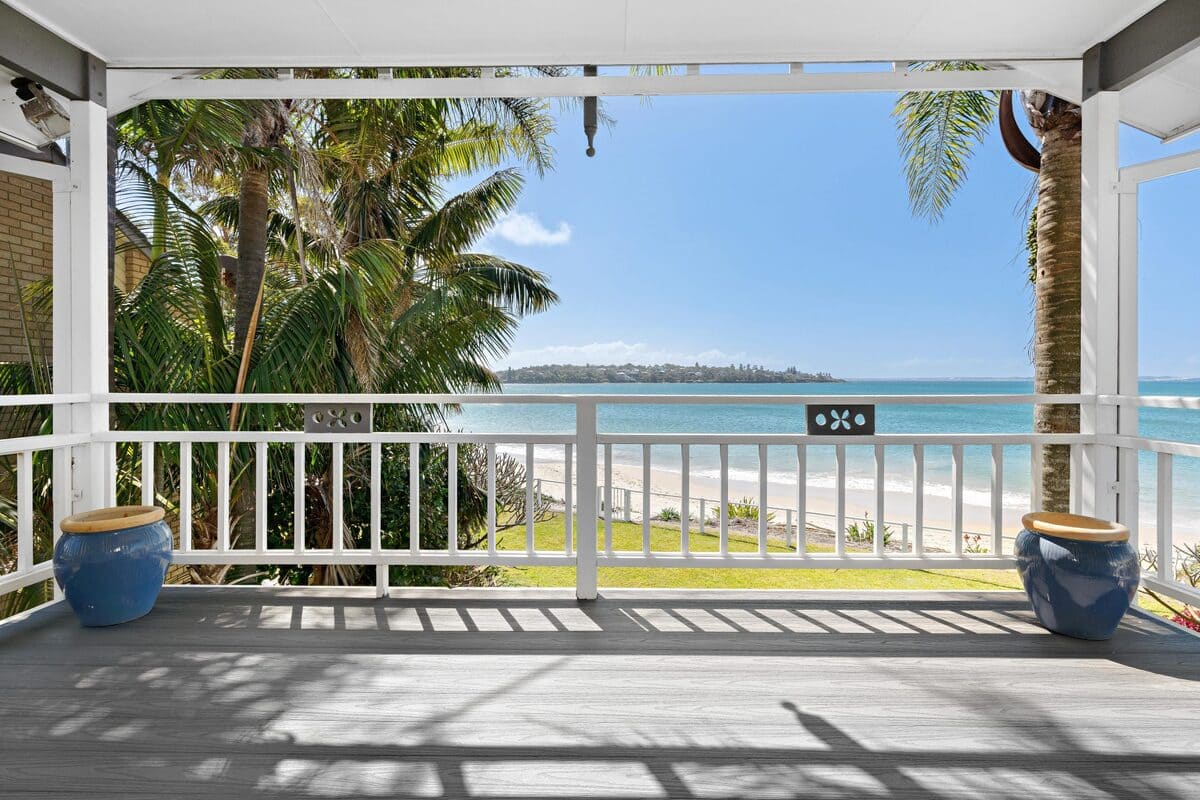
Australia’s climate zones vary widely from tropical north to temperate south. Coastal areas face salt spray and high humidity. Inland regions see sudden storms that wet decks and blow in dust. Homeowners must adapt cleaning schedules to local conditions for best results.
Sunlight intensity changes with latitude and season. Strong UV in northern regions speeds drying but can fade board colours. Southern areas have gentler sun but cooler temperatures that slow evaporation. Observing local weather patterns helps you plan timely cleaning inspection and protection.
Airborne pollen peaks in spring adding fine organic matter that mixes with dew to form sticky residue. Summer storms wash sand or dust into grooves. Adjusting cleaning frequency around these events keeps surfaces clear and mould growth at bay.
Impact of humidity and rainfall patterns on mould formation
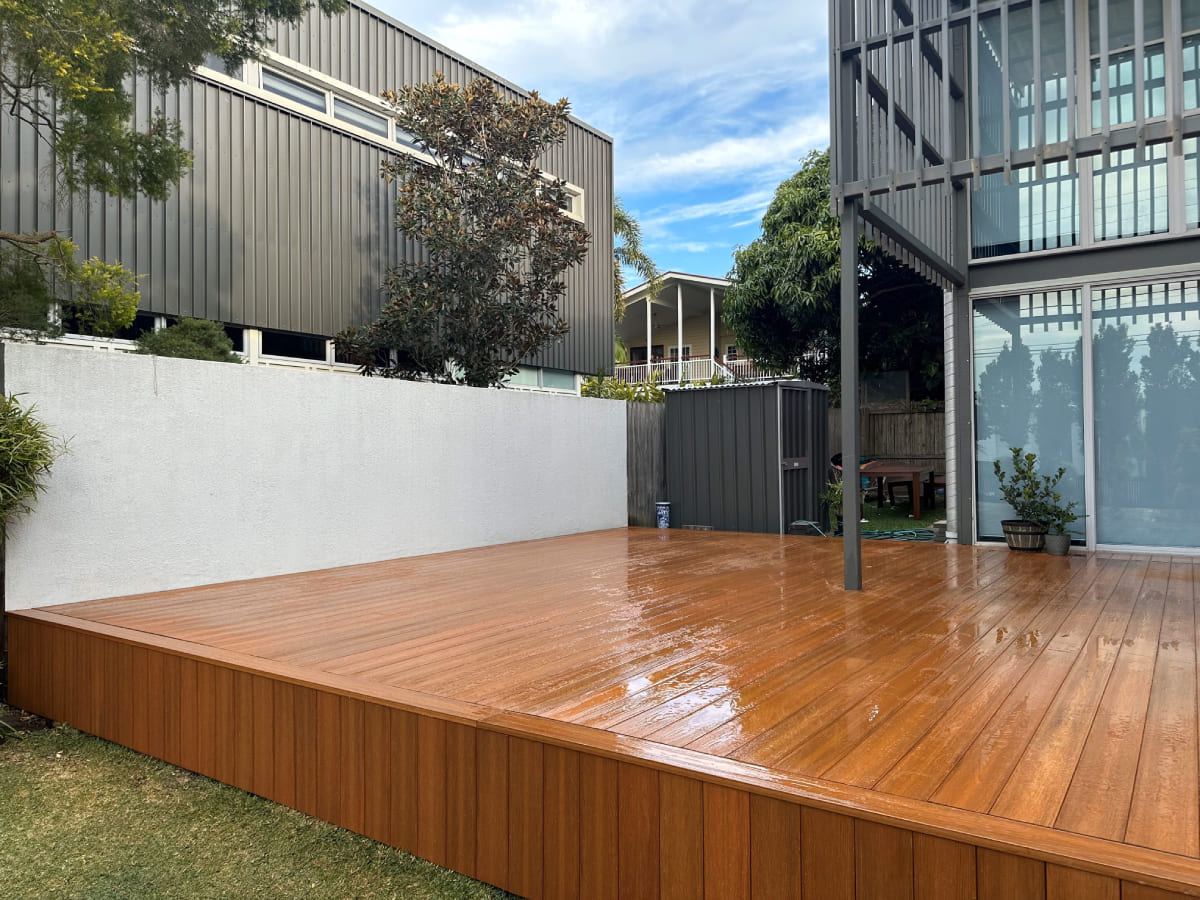
Frequent rain means decks rarely dry fully. Tropical Queensland decks stay damp year round and call for weekly rinses. In Melbourne rainfall peaks in winter so deep cleans in spring and autumn work best. Transitional Adelaide summers are dry but humid winter mornings leave heavy dew on boards.
Humidity over fifty per cent for days creates ideal mould conditions. Coastal cities often see sustained high humidity so bi weekly scrubs under shade help. Inland areas need only monthly routines outside wet seasons. Matching cleaning frequency to local climate prevents wasted effort.
Rain after desert dust storms washes fine particles into grooves where they hold moisture like a sponge. Pre-washing loose dust away or covering decks before storms reduces residue buildup. Tailoring care to weather extremes keeps boards performing well.
Role of shaded and poorly ventilated areas
Decks under trees or solid shade rarely get direct sun. Without sunlight or wind patches of dampness form in board channels and around hardware. mould appears first under planters where airflow is weakest. Moving pots and trimming overhangs improves drying.
Proper under deck ventilation prevents moisture traps below boards. Blocking gaps with lattice or mulch cuts airflow. Loose gravel or crushed rock allows breezes to dry sub deck spaces. Installing joists with adequate spacing and rim joists with vents avoids damp conditions on both sides of the boards.
Leaving a small gap between deck edge and wall helps air circulate. Walls radiate heat back and trap moisture in narrow gaps. A five centimetre clearance makes a big difference in drying edges and preventing mould growth.
Preventing mould at the Design Stage
Smart design reduces water retention from day one. A slight slope of two degrees away from the house ensures swift runoff. Proper joist spacing and open under deck clearances prevent pools of water or debris beneath boards. These details cut maintenance time over the deck’s lifetime.
Choosing boards with enhanced protective caps and self draining groove profiles helps shed debris in heavy rain. Some profiles use micro grooves engineered to minimise dirt traps. Pairing these boards with a metal substructure boosts durability and drying in harsh climates.
Planning for future cleaning such as removable planks or access panels in rail assemblies eases upkeep. Adding drainage channels in joist bays directs water to drains. Thoughtful design balances aesthetics with functionality to prevent mould.
Proper board spacing and airflow considerations
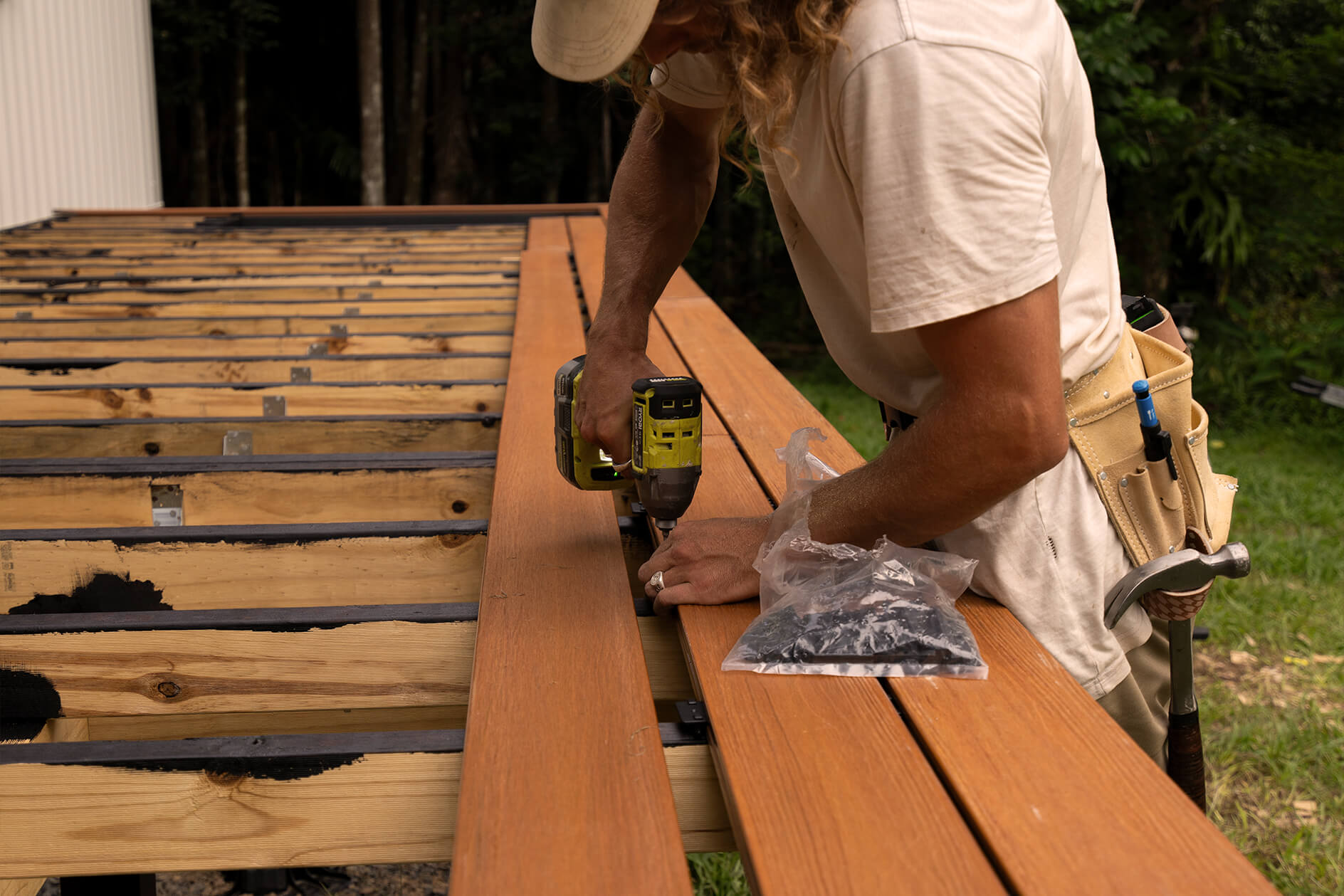
Correct gaps, spans, and airflow are essential for deck performance and longevity.
Maintain a 5 mm gap when using the BriteDeck® concealed fastening system to allow water and debris to fall through. A narrower 3 mm gap can be achieved using a 3 mm clip, which may be required for decks needing Bushfire Attack Level (BAL) compliance. For butt joints and breaker boards, refer to the expansion gap chart in the Installation Guide, adjusting for board length and the temperature at the time of installation.
For residential joist spacing, the maximum spans are 350 mm for both HD Urban X and NextGen Titanium, and 400 mmfor HD PRO. If you’re laying boards at an angle, make sure the furthest support joint does not exceed these limits.
Ground clearance is equally important. Maintain at least 300 mm (30 cm) from the soil to the underside of the joists for normal ground conditions. For concrete or other hard surfaces, refer to the Installation Guide for specific requirements. This clearance helps the boards dry evenly and allows easy access for cleaning with a broom or hose.
Proper ventilation is essential. Avoid boxing in or sealing the underside of the deck, as this can trap moisture. Good airflow beneath the boards prevents hidden damp spots and extends the life of your deck.
Finally, consider how your balustrades and railings affect airflow. Closely spaced balusters can restrict breezes and create shaded areas along deck edges. Where possible, angle or design rails so they allow air to pass through and encourage rainwater to run off.
Substructure and drainage design to discourage moisture build up
Metal joists made of galvanised steel or aluminium resist rust and fungal growth. Even treated timber joists require good airflow to avoid moisture retention under boards. Metal subframes combined with composite boards last longest in damp conditions.
A gentle pitch of two to three degrees ensures water flows off boards. Collect runoff in troughs and guide it through downpipes away from foundations. Gravel beds or French drains under the deck transport water clear of the structure, reducing rot risk in joists and footings.
For balconies and upper level decks install linear drains at the perimeter. These discreet channels catch water and carry it away, preventing overflow onto lower levels. Proper drainage planning avoids expensive retrofits and protects your investment.
Routine Cleaning Practices
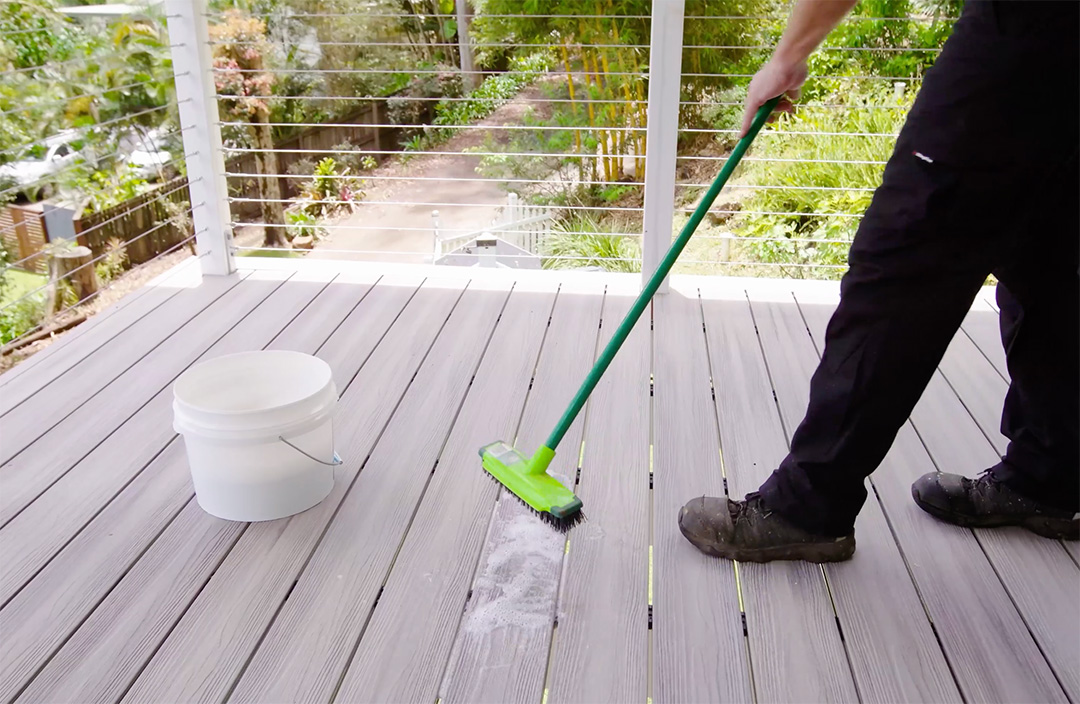
Routine cleaning removes spores before they establish colonies. In dry inland areas a quarterly sweep and rinse suffices. In humid or shaded locations plan a quick rinse every two weeks and a soft scrub monthly. Frequent light cleaning cuts down the need for strong detergents.
Use a mild soap or a manufacturer approved deck cleaner. Harsh solvents can strip the protective cap and void warranties. Mix cleaners per instructions and scrub gently with a soft bristle brush. Rinse thoroughly to remove all residue.
Avoid pressure washers over fifteen hundred PSI as they can etch the cap layer and expose the core. If you use one, keep the nozzle at least three hundred millimetres away and select a fan tip to disperse water gently. Slow sweeping strokes clean without damage. Start the project in an area removed from the main walkways as a trial to ensure your use of the nozzle does not damage your boards
How often to clean composite and timber decking in sydney and different climates
In regions with low humidity such as inland Western Australia a quarterly cleaning schedule works well. Coastal Sydney decks with salt spray and high humidity benefit from monthly wash downs. Tropical north decks often need weekly rinses and bi weekly scrubs during the wet season.
After high pollen periods in spring or leaf fall in autumn quick spot cleans remove organic residue. Adjust cleaning frequency to seasonal debris levels and local weather forecasts. A few extra minutes now prevent bigger tasks later.
Recommended cleaning agents and tools for safe mould prevention
A mix of warm water and dishwashing liquid handles most dirt and light mould. For tougher spots combine one cup of white vinegar with four litres of water and let it sit for ten minutes before rinsing. Vinegar lifts spores without harming the cap layer.
A household detergent and a gurney can help clean tougher, more stubborn stains, and cleaners specifically designed for composite decking can also be used. Always wear gloves and eye protection, and test any new cleaning solution on a hidden section of the deck first. Follow all label directions to ensure your warranty remains valid.
Choose a medium stiff deck broom for general scrubbing and a nylon groove brush for channels. A long handle avoids bending and speeds the process. After cleaning, inspect gaps and joist bays for trapped debris and rinse again if necessary.
Methods for Removing mould
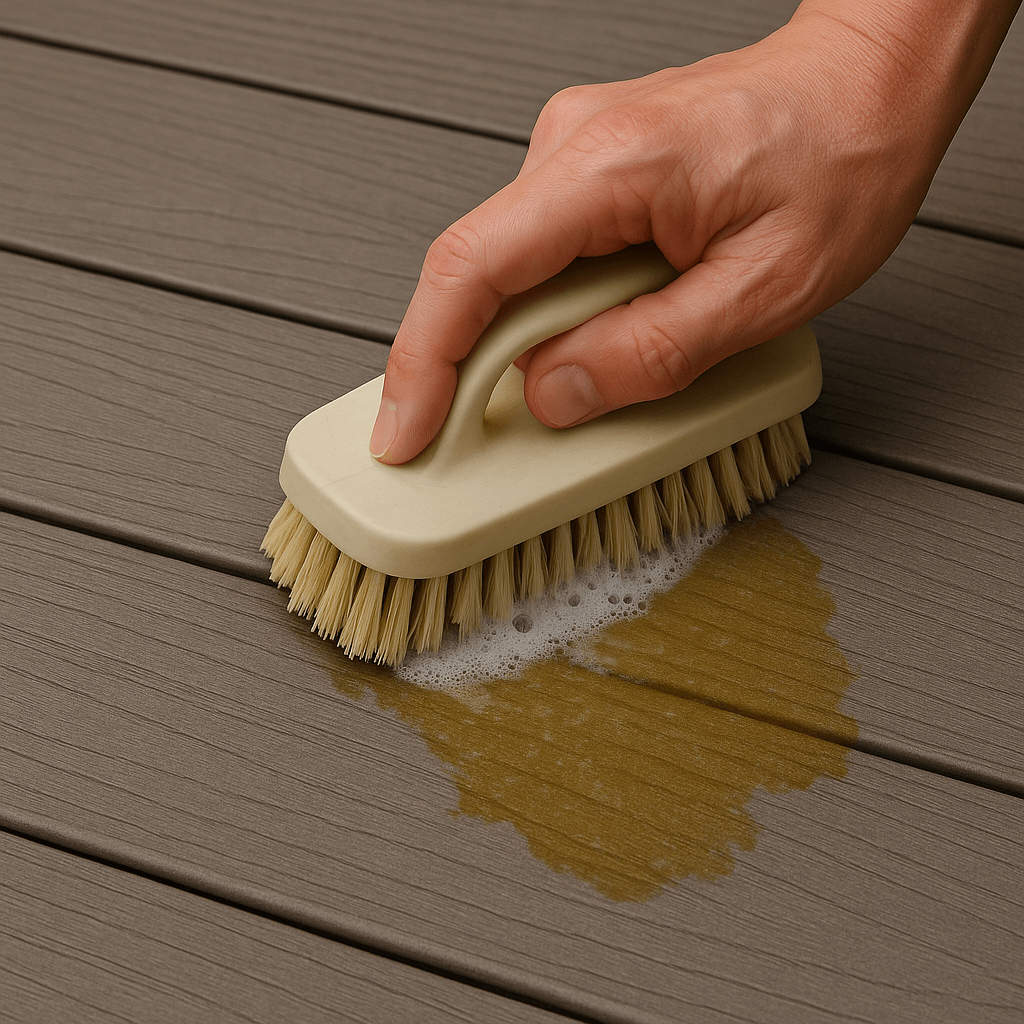
When mould appears, act promptly to stop it from spreading. Start with light cleaning and move to stronger treatments only if needed. Avoid abrasive pads, as they can scratch and weaken the protective cap on composite boards.
Clean during cooler parts of the day — early morning or late afternoon — so cleaning solutions can dwell without evaporating too quickly. Rinse thoroughly and let the deck dry completely before allowing foot traffic. This helps prevent leftover cleaner residue from feeding new growth.
For stubborn black streaks or visible mould, Brite Decking recommends a two-step treatment:
Composite Bright Cleaner (Primary Treatment)
- Start with a 4:1 dilution ratio (1 part cleaner to 4 parts water).
- If stains persist, apply at full strength.
- This cleaner is designed to remove surface mould effectively without damaging the composite finish.
- If mould returns after the initial cleaning, apply No Fungal Pro to kill underlying spores and help prevent regrowth.
Remember, mould spores are invisible to the eye and can transfer from surrounding areas underfoot. For best results, treat any nearby concrete, pavers, or shaded surfaces at the same time to prevent cross-contamination. Avoid bleach or acidic cleaners, as they can discolour or damage the composite surface.
Effective Cleaning Techniques
For large decks, divide the surface into sections. Spray cleaner onto one section, scrub with a soft broom, and rinse before moving on. This prevents areas from drying before they’re fully cleaned, ensuring even treatment.
Long term Maintenance Strategies
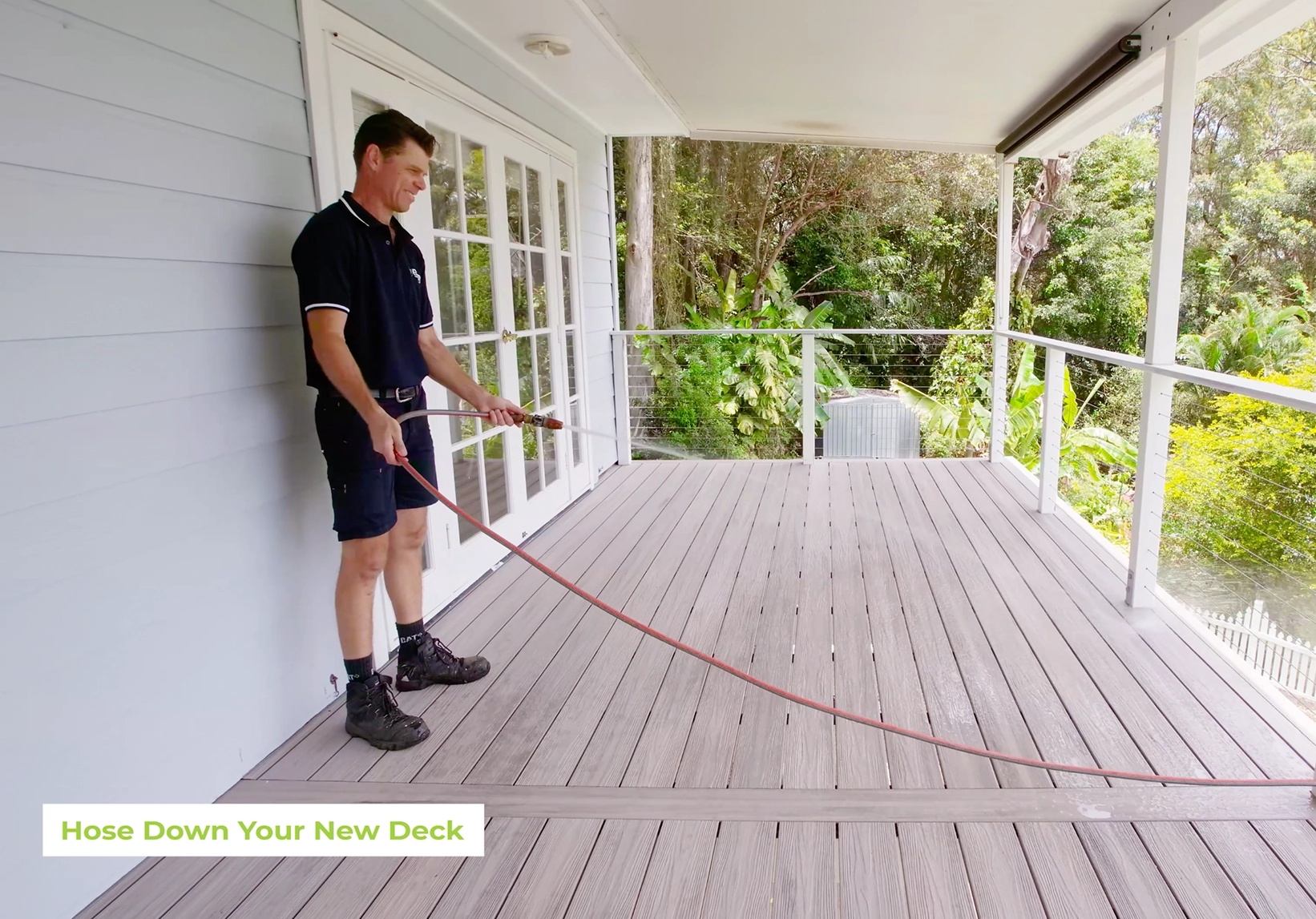
Plan deep cleans each spring and autumn to prepare for wet and dry seasons. Keep a simple calendar reminder or journal of maintenance dates. Consistent records help you stick to routines and spot trouble areas early.
Inspect boards and fasteners twice a year for wear or damage. Replace cracked boards promptly. Tighten loose screws and check hidden clips to avoid movement that traps debris.
Seasonal inspection checklists and upkeep routines
In spring sweep the deck scrub grooves clear gutters above the deck if present and inspect joist vents. Log completion dates to track maintenance history and identify recurring issues.
In autumn remove leaves immediately and rinse earth stains. Treat shaded or damp areas with vinegar solution. Ensure gaps beneath boards and between railings remain clear before winter rains.
Summer inspections focus on colour fade from UV exposure. After cleaning apply sealer if recommended. Check fastener tightness and board alignment to prevent debris traps during windy periods.
Health and Safety Implications of mould
Mould can release spores that irritate lungs and trigger allergies. People with asthma or sensitivities may cough, sneeze or develop skin irritation. Prompt removal lowers exposure for everyone.
Slippery mould patches increase fall risk especially around pools or outdoor dining areas. A clean deck surface maintains good grip. Regular cleaning guarantees safe footing and peace of mind.
Wear gloves, eye protection and a dust mask when cleaning. Afterward wash clothing separately to avoid bringing spores indoors. Proper disposal of cleaning materials prevents cross contamination.
Potential health risks associated with mould exposure
Inhaling spores can aggravate asthma and cause allergic rhinitis. Extended exposure can lead to chronic respiratory problems in vulnerable people. Children and pets are especially sensitive to airborne spores.
Skin contact with mould can cause itching or rash in some individuals. Removing spores promptly prevents prolonged skin irritation. Rinsing surfaces thoroughly ensures no residue remains for bare feet to contact.
Mould near doors and windows can enter homes when disturbed. Cleaning decks reduces indoor spore counts and supports overall household health.
Safe removal disposal and protective gear recommendations
Collect scraped off mould in disposable towels or cloths sealed in plastic bags before discarding. Rinse brushes and brooms outdoors and let them dry in sunlight to kill lingering spores.
Use chemical resistant gloves when handling stronger cleaners. Wear goggles to shield eyes from splashes and a mask to filter airborne particles. Avoid touching your face during cleaning.
After cleaning, launder clothing in hot water and dry in direct sun. Dispose of heavily soiled tools or wash them separately. Good hygiene and disposal practices prevent spore spread.
Warranty and Manufacturer Guidelines
Most structural warranties cover defects but exclude surface growth removal. Check your warranty for exclusions relating to mould or mildew. Following care recommendations preserves coverage.
Manufacturers provide online care manuals and videos detailing cleaning intervals approved products and pressure washer limits. Adhering to these instructions keeps boards performing as intended and within warranty terms.
Manufacturer’s care recommendations and maintenance requirements
Visit the manufacturer’s website for detailed care guides and installation tips. Bookmark relevant pages for quick reference on cleaning and inspection procedures.
Some brands offer free replacement boards under structural warranties if flaws appear. Mould related issues rarely qualify. Understanding warranty scopes sets realistic expectations and prevents disappointments.
Keep customer service contact information handy for quick advice on unexpected problems. A short call can confirm whether a new cleaning method is safe for your specific board profile and warranty.
Cost Considerations for mould Management
Preventative maintenance costs include cleaners, brushes and sealants. Most homeowners spend under two hundred dollars per year on supplies. Compared to timber decks that need annual sanding and sealing, composite remains a very economical choice.
Reactive cleaning after heavy mould outbreaks often requires professional soft washes. These range from three to five dollars per square metre. A single service for a one hundred square metre deck may cost between five hundred and one thousand dollars.
Investing in sealants adds fifty to one hundred dollars every two years. That small outlay extends the time between major cleans and cuts labor costs. Budgeting for regular upkeep ensures no surprise expenses.
Cost comparison of preventative measures versus reactive cleaning
A basic cleaning kit of mild detergent broom and hose costs around fifty dollars. Monthly use stretches supplies across the year. Hiring a professional soft wash for a one hundred square metre deck may cost $800 minimum for one visit.
Replacing warped or damaged boards starts becomes a much more cost effective option even when factoring installation. Preventing moisture entry through regular care avoids these repair bills and protects your deck investment.
Budgeting for regular maintenance and occasional deep cleaning
Allocate two hundred dollars each spring for a deep clean and sealant application. Set aside fifty dollars each quarter for spot cleans and supplies. Tracking expenses in a simple spreadsheet keeps you on schedule and budget.
For large decks consider maintenance plans that bundle quarterly inspections with an annual professional wash. Service plans spread costs evenly and guarantee expert care. Compare local quotes to find the best rates.
Include a contingency fund of five hundred dollars for unexpected repairs or professional mould removal. Having funds ready prevents delays in addressing issues before they worsen and keeps your deck in top condition.
Common Myths and Misconceptions
- Myth: Composite decking never grows mould. Even engineered boards can host surface mould if debris and moisture combine. Regular cleaning stops small spots from spreading.
- Myth: Pressure washing is always safe. Reality high pressure can damage protective caps and void warranties. Use gentle cleaning methods approved by manufacturers.
- Myth: Chemical treatments provide permanent protection. Truth no coating lasts forever. Sealants slow mould but need reapplication. Routine cleaning remains crucial.
Debunking myths about composite decking and mould growth
Composte decking means low maintenance living, not maintenance free. Building simple cleaning into your routine prevents major issues. A monthly sweep and rinse removes most debris before spores settle.
Sealants help but are optional. Many homeowners skip them relying solely on the board cap. Adding a compatible sealant improves water beading and extends cleaning intervals.
Warranties vary. Some include fade and stain coverage but exclude mould. Reading fine print and following care instructions avoids claim rejections and surprise costs.
Clarifying long term performance expectations
Properly installed and cared for composite decks last twenty to thirty years. Expect light cleaning every few months and deep cleans annually. Minor mould in shaded areas is normal and easy to remove.
Colour retention depends on UV exposure and board quality. Premium boards hold colour longest while budget lines may fade faster. Investing more up front in quality profiles reduces cleaning needs and extends deck life.
Plan for fifteen to twenty minutes of cleaning per month for most decks in moderate climates. Increase effort in high humidity zones. Small regular steps keep your deck looking new and safe for everyone.
Frequently Asked Questions
Can mould void my composite decking warranty?
Mould alone rarely voids structural warranties but may exclude surface guarantees if improper care caused staining. Review your warranty exclusions carefully. Following the manufacturer’s cleaning guidelines maintains coverage.
Document maintenance dates and cleaning products to support any valid claim. If unsure contact customer service before using new cleaners.
How often should I inspect and clean to keep mould at bay?
Inspect monthly focusing on shaded and damp spots. In humid climates rinse and sweep every two weeks and scrub monthly. In dryer zones a quarterly schedule usually suffices.
Deep clean and apply sealant each spring and autumn to prepare for changing seasons. Adjust frequency to local weather and deck exposure levels.
Which boards perform best in high humidity regions?
Boards with thicker protective caps and integrated antimicrobial additives can reduce the appearance of most effectively. Co extruded shells outperform capped shell designs in very damp areas. Choose profiles rated for subtropical climates for best results.
Check manufacturer specs for cap thickness and warranty coverage. Investing in premium boards lowers cleaning frequency and extends surface life.
Where can I compare composite decking prices?
Visit the pricing section on the manufacturer’s site to view current composite decking prices. Costs vary by profile finish and length. Always include installation estimates when budgeting to get an accurate total cost.

